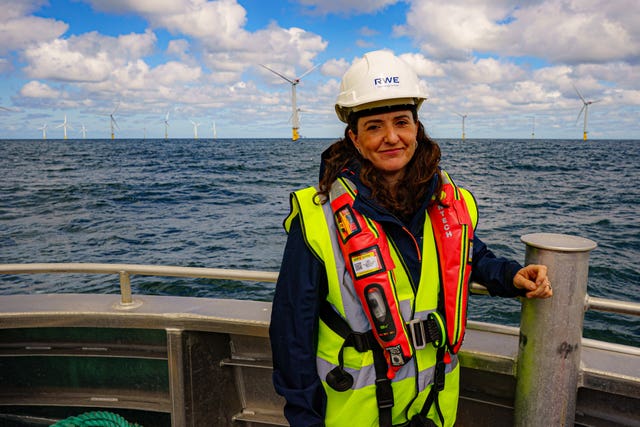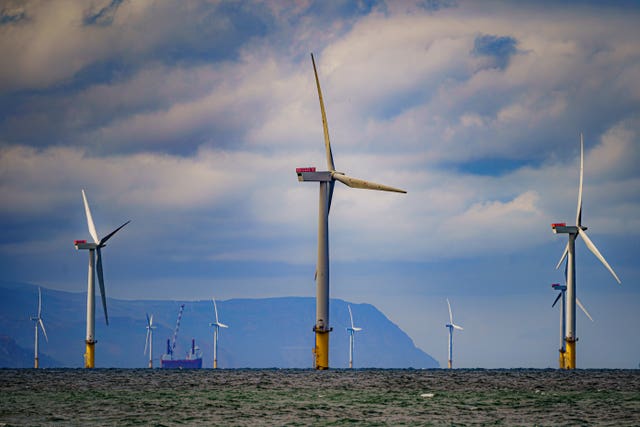Huge new offshore wind farm ‘could power a third of Welsh homes’
The wind farm, still in its planning phase, could supply energy to around 500,000 of the country’s 1.38 million households.

A huge new offshore wind farm could power over a third of Welsh homes with renewable energy, those behind the project have claimed.
The wind farm, which is still in its planning phase but is set to include up to 50 turbines, could supply energy to around 500,000 of the country’s 1.38 million households.
If built, Awel y Mor could help tackle climate change and minimise the UK’s reliance on imported energy, German-owned energy company RWE Renewables has said.
It could also cut energy costs and help the Welsh Government reach their 70% renewable energy target by 2030.
But critics of the scheme say the turbines, which would stand just over 10km off the north Wales coast, would harm marine life and affect tourism by spoiling the views from Snowdonia, other beauty spots and conservation areas.
Speaking to PA news agency from Gwynt y Mor wind farm, located in the Irish Sea, Tamsyn Rowe, RWE project lead, said: “Awel y Mor would be a fantastic opportunity for Wales. It would bring significant benefits in terms of helping the Welsh Government meet their renewable energy targets of 70% by 2030.

“It would also bring lots of skills and supply chain opportunities and jobs to the region.
“If it’s approved, as the project is in an early stage at the moment, it could power up to 500,000 homes with green, clean, renewable energy.
“Climate change is real, it’s happening now and we do need to be acting urgently,” she added.
“Projects like Awel y Mor could help us de-carbonise society and protect it for future generations.
“They also have the benefit of helping the UK’s security of supply, which is a really important issue at the moment, and help us reduce our reliance on imports whilst also reducing the cost of energy to the consumer.”
Awel y Mor would be situated to the west of the existing Gwynt y Mor wind farm and create 1100MW of energy with its grid connection planned to reach the shoreline between Rhyl and Prestatyn.
Ms Rowe said the company had spent three years preparing surveys on sea bed ecology, and on the bird population due to the proposed turbines being larger and having a maximum tip height of 332m.
RWE reduced the number of turbines to address concerns over the visual landscape raised during a public consultation last autumn.
In May, the proposals were accepted for consideration by the UK Planning Inspectorate.
Members of the public will be able to submit their thoughts on the project to the planning body from next month.
The final decision on consent will rest with the UK Secretary of State for Business, Energy and Industrial Strategy, with a decision anticipated in 2023.
The project lies in Welsh waters and therefore a Marine Licence must also be granted by the Welsh Government through Natural Resources Wales whose consultation ends on August 18.

If permission was granted, Awel y Mor and Gwynt y Mor combined would have the capacity to power the equivalent of more than one million Welsh homes.
RWE is already the largest provider of renewable energy in Wales and it is now looking at building floating wind farms off the south coast of Wales.
Ms Rowe said: “Floating wind opens up whole new geographical areas around the coastline of the United Kingdom and Wales where we can deploy turbines in deeper water.
“The Crown Estate has recently announced a leasing round for around four gigawatts of floating turbines in the Celtic Sea, so off the south coast of Wales.
“RWE are seeking to develop at least one gigawatt of commercial scale floating in that area.”
RWE has already began working with ports in South Wales to help them get ready for the floating turbine industry.
Last month the company struck up a partnership with Tata Steel to explore how components for the high-tech floating wind turbines might be produced by the Port Talbot steelworks.





